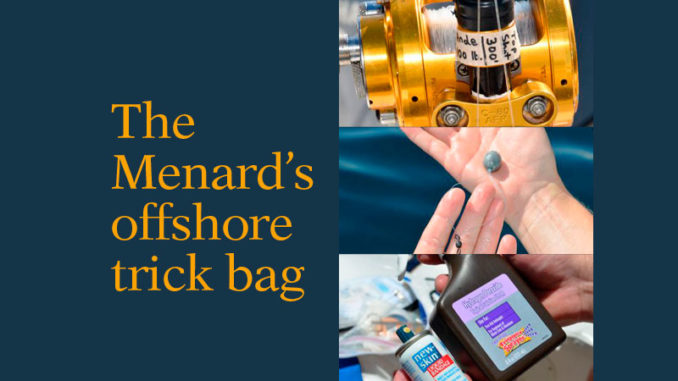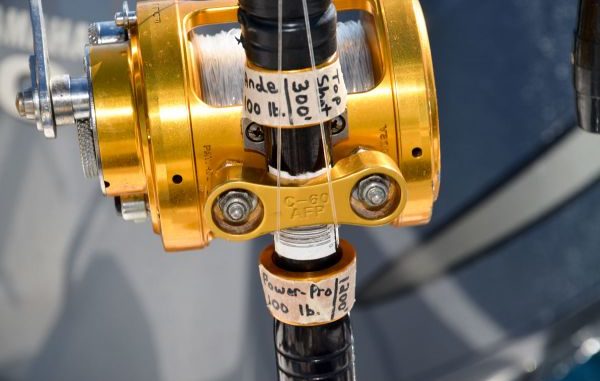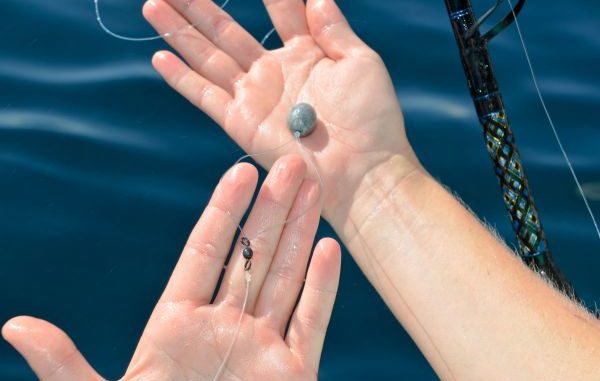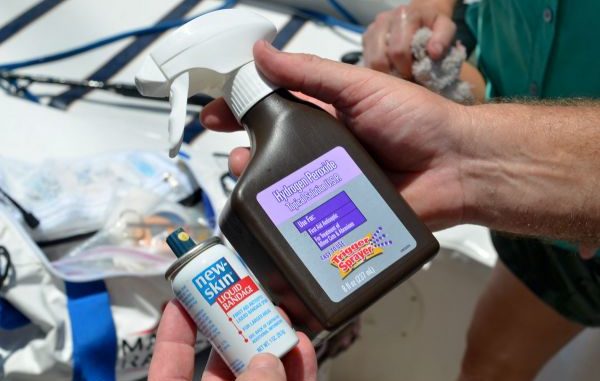
One of the fun things about fishing with other people is learning little short-cuts and tricks they use to make their fishing experience better and catch more fish.
Here are a few of Dennis and Amanda Menard’s tricks for better trips.
Label your rods
Sports fishermen like to tinker with and test new lines. Offshore fishermen might be the worst, mainly because their boats are large enough to store a couple of dozen rods.
Trying to remember what line or leader a particular rod was spooled with can be dizzying.
 The Menards solved that problem by labeling a piece of easy-to-remove masking tape on the rod with the particulars that they need to know about the reel’s contents.
The Menards solved that problem by labeling a piece of easy-to-remove masking tape on the rod with the particulars that they need to know about the reel’s contents.
“We are big believers in PowerPro braided lines,” Dennis said, “but like to experiment with a lot of other lines.”
Loop your snapper lines
Dennis makes the terminal rigs on his snapper lines a little differently than most people.
He inserts the main line from the reel through an egg sinker, typically a 1/2-ounce, for mangrove snappers, and then he ties a loop in the line with a double overhand knot. Leaders are made of 50-pound-test fluorocarbon line with a swivel on one end and a 5/0 circle hook on the other end.
The swivel on the leader is passed through the bottom of the main line loop to attach the leader to the line.

This arrangement makes the sinker ride on the knot above the swivel rather than on the swivel itself, where it can abrade and weaken the line.
Prep your Sabiki rigs beforehand
Sabiki rigs, which come with six mini-jigs, are ideal for catching bait species such as hardtails.
To save fishing time, the Menards open the jig packs and add a ¾-ounce bell sinker to the bottom of each rig, which they then roll up and put in a zipper-type plastic bag, ready to fish.
Try a patch for seasickness
Seasickness is miserable. Some, when severely sick, say you have to get better just to die.
Treatments for seasickness come in many forms: liquids, pills, pressure bracelets and even herbal remedies such as ginger.
What the Menard family has found to be most effective are Transderm-scop patches. These coin-sized and shaped patches release scopolamine into the body through the skin where applied.

Nicole Menard never leaves the dock without one on behind an ear.
“I used to get sick every single time we fished,” she said. “Now, I haven’t gotten sick once this year, and I’ve been offshore five times.”
Because of potential side effects, Transderm-scop patches are only available with a prescription from a medical professional.
Pre-tie all fishing leaders at home
With long runs to get to snapper waters, time on fishing grounds is precious. Leaders pre-tied at home and ready to go make rerigging quick and easy after a hook is lost.
Store the leaders in zipper-style plastic bags to avoid tangles. Labeling the bags with a permanent marker is important.
First aid stuff is important
Nicks, cuts and scrapes are unavoidable on an offshore fishing boat.
The Menards’ boat never leaves the landing without two items: a spray bottle of hydrogen peroxide and New Skin Liquid Bandage.
The hydrogen peroxide kills all bacteria.
“Everyone should have that on their boat,” Dennis said.
The New Skin Liquid Bandage is sprayed on a wound and seals it like new skin, he explained.
“It works good in this type of environment,” Dennis said. “As many nicks and cuts as we get, no one has ever gotten infected on our boat.”